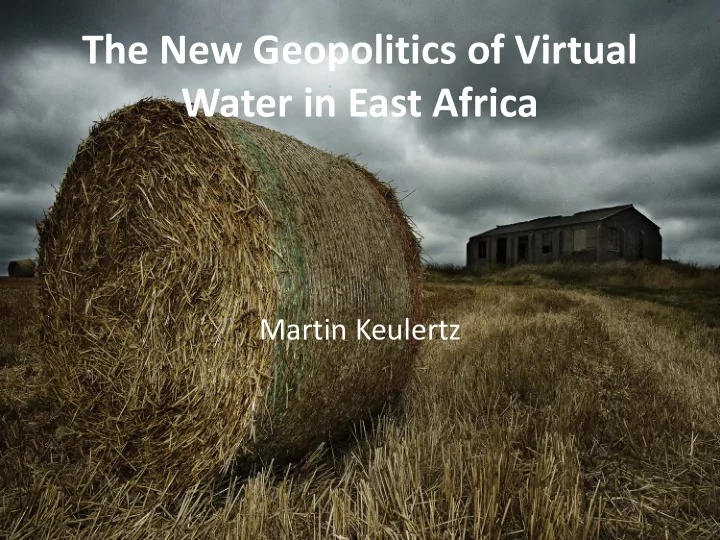

The New Geopolitics of Virtual Water in East Africa Martin Keulertz
Investing countries’ water poverty as key driver of ‘land grabs’ • High population growth and decreasing water resources increase pressure on agriculture and thus food security • Potential alternatives are located in overseas investments. • ‘Virtual water’ either traded or grabbed as the key concept to understand land grabs
Source: IndexMundi, 2011 100 150 200 250 300 350 400 450 500 100 200 300 400 500 600 50 Staple food prices per ton since 2001 0 0 Feb-01 Feb-01 Wheat (US Dollar per metric ton) Soybeans (US Dollar per metric Sep-01 Sep-01 Apr-02 Apr-02 Nov-02 Nov-02 Jun-03 Jun-03 Jan-04 Jan-04 Aug-04 Aug-04 Mar-05 Mar-05 ton) Oct-05 Oct-05 May-06 May-06 Dec-06 Dec-06 Jul-07 Jul-07 Feb-08 Feb-08 Sep-08 Sep-08 Apr-09 Apr-09 Nov-09 Nov-09 Jun-10 Jun-10 Jan-11 Jan-11 10 15 20 25 30 35 100 120 140 160 180 200 20 40 60 80 0 5 0 Feb-01 Feb-01 Aug-01 Aug-01 Sugar (US Dollar cents per pound) Feb-02 Beef (US Dollar cents per pound) Feb-02 Aug-02 Aug-02 Feb-03 Feb-03 Aug-03 Aug-03 Feb-04 Feb-04 Aug-04 Aug-04 Feb-05 Feb-05 Aug-05 Aug-05 Feb-06 Feb-06 Aug-06 Aug-06 Feb-07 Feb-07 Aug-07 Aug-07 Feb-08 Feb-08 Aug-08 Aug-08 Feb-09 Feb-09 Aug-09 Aug-09 Feb-10 Feb-10 Aug-10 Aug-10
Source: www.waterfootprint.org
Global ‘Virtual Water’ flows Source: www.waterfootprint.org
Pragmatic responses to meet Middle Eastern ‘virtual water’ demands • European consumers are highly dependent on ‘virtual water’ flows from Latin America and Africa • Middle East imports roughly 70-90% of their water needs in the form of commodities from overseas • Middle Eastern economies are still highly dependent on Western wheat imports • Investment banks have discovered commodity trading as a means to create revenues • Dependence on global market supply is a risky strategy at a time of new powers emerging in East and South Asia and unforeseen events such as Russian fires in 2010. • Supply-side increases required
The picture from South Sudan
The opportunities • The Sudd could potentially become a major ‘breadbasket’ • Cheap availability of land • Water productivity could be increased • The Arab water question could be solved by virtual water imports
Cultural and social investment risks (in water-rich Southern Sudan) • Subsistence farmers are used to enforce customary law through their Kalashnikovs • Cows are an economic exchange good for women Frequent tribal clashes over land • and water issues Local workforce is untrained and • traumatised after 50 years of civil war • Hardly any operational infrastructure • Very few projects are operational and if so place emphasis on green water management
The soil predicament on the case of Sudan Source: FAO
Tropical soils as a major hindrance for agricultural investments • Intensive farming through ‘blue’ water irrigation as a high risk strategy for soils • ‘Green’ water or root-zone water management more sustainable but once again high risk • Required commodities can only produced at high economic and environmental costs • Possible cropping is economically unattractive (paddy rice) • ‘Serious’ investors in land and agriculture choose Eastern Europe, Turkey, US or Latin America as their investment areas
Geopolitical factors • The African ‘shatter belt’ is currently in a state of reshaping • virtual extension of the investors’ Lebensraum • South Sudan crucial for regional, Eastern and Western infrastructure plans • Costly mega-investments are contested between global powers • ‘Hidden agendas’ (mainly agriculture-oil nexus) prevail
The ‘new great game ’ in Africa Lamu port Gwadar port
Conclusions • FDI in Sub-Saharan agriculture is a high-risk strategy • ‘Root-zone’ water management economically less costly but high-risk • Blue-water management economically unfeasible • Required crops such as wheat cannot be grown in East Africa • ‘Food and land bubbles’ may burst • Virtual land grabs prevail
Many thanks!!!
Recommend
More recommend